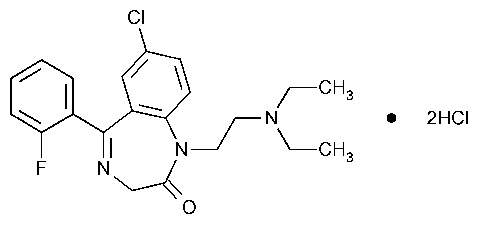Flurazepam Hydrochloride
2H-1,4-Benzodiazepin-2-one,7-chloro-1-[2-(diethylamino)ethyl]-5-(2-fluorophenyl)-1,3-dihydro-,dihydrochloride.
7-Chloro-1-[2-(diethylamino)ethyl]-5-(o-fluorophenyl)-1,3-dihydro-2H-1,4-benzodiazepin-2-one dihydrochloride [1172-18-5].
Change to read:
»Flurazepam Hydrochloride contains not less than 99.0percent and not more than 101.0percent of C21H23ClFN3O·2HCl,calculated on the  anhydrous
anhydrous USP28basis.
USP28basis.
Packaging and storage—
Preserve in tight,light-resistant containers.
USP Reference standards á11ñ—
USP Flurazepam Hydrochloride RS.USP Flurazepam Related Compound C RS.USP Flurazepam Related Compound F RS.
Identification—
A:
Infrared Absorption á197Kñ.[NOTE—Do not grind excessively,as decomposition may occur.]
B:
Ultraviolet Absorption á197Uñ—
Solution:
10µg per mL.
Medium:
sulfuric acid in methanol (1in 36).
Absorptivities at 239nm,calculated on the dried basis,do not differ by more than 3.0%.
C:
Prepare a solution of it in methanol containing 3mg per mL.Apply 10µLof this solution and 10µLof a methanol solution of USP Flurazepam Hydrochloride RScontaining 3mg per mLto a suitable thin-layer chromatographic plate (see Chromatography á621ñ)coated with a 0.25-mm layer of chromatographic silica gel mixture.Allow the spots to dry,and develop the chromatogram in a solvent system consisting of a mixture of ethyl acetate and ammonium hydroxide (200:1)until the solvent front has moved about three-fourths of the length of the plate.Remove the plate from the developing chamber,mark the solvent front,and allow the solvent to evaporate.Locate the spots on the plate by viewing under short-wavelength UVlight:the RFvalue of the principal spot in the chromatogram of the test solution corresponds to that obtained from the solution of the Reference Standard.
D:
To 2mLof a solution (1in 20),add 1mLof 2Nnitric acid:the solution responds to the tests for Chloride á191ñ,5drops of silver nitrate TSbeing used.
Water,Method Ia á921ñ:
not more than 0.5%.
Residue on ignition á281ñ:
not more than 0.1%.
Heavy metals,Method IIá231ñ:
0.002%.
Limit of fluoride ion—
[NOTE—Use plasticware throughout the procedure.]
pH5.25Buffer—
Dissolve 110g of sodium chloride and 1g of sodium citrate in 700mLof water in a 2000-mLvolumetric flask.Cautiously add 150g of sodium hydroxide,and dissolve with shaking.Cool to room temperature,and,while stirring,cautiously add 450mLof glacial acetic acid to the cooled solution.Cool,add 600mLof isopropyl alcohol,dilute with water to volume,and mix:the pHof this solution is between 5.0and 5.5.
Standard stock solution—
Transfer 221mg of sodium fluoride to a 100-mLvolumetric flask,add about 20mLof water,and mix to dissolve.Add 1.0mLof sodium hydroxide solution (1in 2500),dilute with water to volume,and mix.Each mLof this solution contains 1mg of fluoride ions.Store in a tightly closed,plastic container.
Standard preparations—
Dilute portions of the Standard stock solutionquantitatively and stepwise with pH5.25Bufferto obtain 100-mLsolutions having concentrations of 1,3,5,and 10µg per mL.
Test preparation—
Transfer 1.0g of Flurazepam Hydrochloride,accurately weighed,to a 100-mLvolumetric flask,dissolve in and dilute with pH5.25Bufferto volume,and mix.
Procedure—
Concomitantly measure the potential (see Titrimetry á541ñ),in mV,of the Standard preparationsand of the Test preparation,with a pHmeter capable of a minimum reproducibility of ±0.2mV,equipped with a glass-sleeved calomel-fluoride specific-ion electrode system.[NOTE—When taking measurements,immerse the electrodes in the solution,which has been transferred to a 150-mLbeaker containing a polytetrafluoroethylene-coated stirring bar.Allow to stir on a magnetic stirrer having an insulated top until equilibrium is attained (1to 2minutes),and record the potential.Rinse and dry the electrodes between measurements,being careful to avoid damaging the crystal of the specific-ion electrode.]Plot the logarithm of the fluoride-ion concentrations,in µg per mL,of the Standard preparationsversus the potential in mV.From the measured potential of the Test preparationand the standard curve determine the concentration,in µg per mL,of fluoride ion in the Test preparation:not more than 0.05%is found.
Related compounds—
Mobile phase—
Prepare a filtered and degassed mixture of methanol and 1%ammonium acetate (80:20).Make adjustments if necessary (see System Suitabilityunder Chromatography á621ñ).
Standard solution—
Dissolve accurately weighed quantities of USP Flurazepam Related Compound C RSand USP Flurazepam Related Compound F RSin methanol,and dilute quantitatively,and stepwise if necessary,with methanol to obtain a solution having a known concentration of about 2µg per mLfor each component.Prepare fresh daily.
Test solution—
Transfer about 50mg of Flurazepam Hydrochloride,accurately weighed,to a 25-mLvolumetric flask,add methanol to volume,and mix.[NOTE—Prepare this solution just prior to use.]
System suitability solution—
Dissolve accurately weighed quantities of USP Flurazepam Hydrochloride RSand 2-amino-5-chlorobenzophenone in methanol,and dilute quantitatively,and stepwise if necessary,with methanol to obtain a solution having a known concentration in each mLof about 150µg of USP Flurazepam Hydrochloride RSand about 60µg of 2-amino-5-chlorobenzophenone.
Chromatographic system
(see Chromatography á621ñ)—The liquid chromatograph is equipped with a 239-nm detector and a 4.6-mm ×25-cm column that contains packing L1.The flow rate is about 1.5mLper minute.Chromatograph replicate injections of the System suitability solution,and record the peak responses as directed for Procedure:the resolution,R,between 2-amino-5-chlorobenzophenone and flurazepam is not less than 2.Chromatograph replicate injections of the Standard solution,and record the peak responses as directed for Procedure:the relative standard deviation for replicate injections is not more than 2.0%.
Procedure—
Separately inject equal volumes (about 20µL)of the Standard solutionand the Test solutioninto the chromatograph,record the chromatograms,and measure the responses for the major peaks.Calculate the quantity,in percentage,of flurazepam related compound Cand flurazepam related compound Fin the portion of Flurazepam Hydrochloride taken by the formula:
2.5(C/W)(rU/rS),
in which Cis the concentration,in µg per mL,of USP Flurazepam Related Compound C RSor USP Flurazepam Related Compound F RSin the Standard solution;Wis the weight,in mg,of Flurazepam Hydrochloride taken;and rUand rSare the peak responses for the related compounds obtained from the Test solutionand the Standard solution,respectively.The limit is not more than 0.1%of flurazepam related compound Cand not more than 0.1%of flurazepam related compound F.
Organic volatile impurities,Method Iá467ñ:
meets the requirements.
Assay—
Transfer about 600mg of Flurazepam Hydrochloride,accurately weighed,to a 250-mLbeaker,dissolve in 80mLof glacial acetic acid,and add 20mLof mercuric acetate TS.Titrate with 0.1Nperchloric acid VS,determining the endpoint potentiometrically,using a calomel-glass electrode system.Perform a blank determination,and make any necessary correction.Each mLof 0.1Nperchloric acid is equivalent to 23.04mg of C21H23ClFN3O·2HCl.
Auxiliary Information—
Staff Liaison:Salvador C.Salado,M.S.,Scientist and Latin American Liaison
Expert Committee:(PA3)Pharmaceutical Analysis 3
USP28–NF23Page 864
Pharmacopeial Forum:Volume No.30(4)Page 1229
Phone Number:1-301-816-8165
